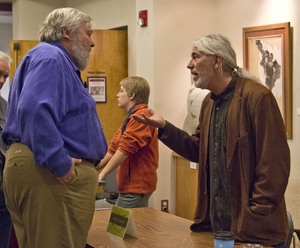Sandoz Society Conference addresses drought

University of Montana history professor Dan Louie Flores presented the fourth annual Pilster Great Plains Lecture to open the annual Mari Sandoz Heritage Society conference last Thursday.
Flores is the A.B. Hammond Chair in Western History at the college in Missoula. He specializes in cultural and environmental studies of the American West and has received an array of awards for articles and books about the Great Plains and Rocky Mountains from west Texas into Montana.
Dave Nesheim, CSC assistant professor of social and communication arts, in his introduction of Flores, pointed out that the author’s article, “"Bringing Home all the Pretty Horses,” has won nine awards.
He told the audience that he, like many others, discovered the literature of the Great Plains through Mari Sandoz. He said the Great Plains stunned him and that all other landscapes suffer in comparison to the prairie.
Although most of his comments and photos centered on the history of the Folsom and Clovis cultures about 300 miles south of Chadron, he spoke with an obvious passion for the plains. He said the landscape of Sandoz has charisma as endless as the ocean seas.
While he lamented that prairies have been de-buffaloed, de-wolfed and de-grassed, the Louisiana native gave a nod to the “possibilism” mentality of the settlers who surveyed their surroundings and found various ways to use nature’s resources.
During the panel discussion Friday about ranching and grazing during a drought, Dr. Jim O’Rourke offered a clarification to a comment made by Flores the evening before.
“When hot, dry and windy conditions last for thousands of years, that’s not drought, that’s aridity,” O’Rourke said.
Other panelists included Dr. Ron Bolze, lecturer in applied sciences; Anthony Perlinski, assistant professor in applied sciences, Clint Phillips, with the Nebraska Forest Service; and Dr. Teresa Frink, associate professor and applied sciences department chair.
O’Rourke and others on the panel agreed that possessing a thorough knowledge of plant taxonomy, physiology and the timing of grazing are of utmost importance when it comes to the long-term health of grazing lands. The panel entertained questions from the audience about the effects of drought on livestock and wildlife. Frink shared an example of the mother white tail or mule deer which is able to extend its intestines to absorb more moisture while lactating.
Woven wire fences and poorly designed fences can impair the movement of some wildlife to water sources, like antelope which prefer to avoid jumping fences when possible, she added. O’Rourke encouraged those in the audience to become involved in tax reform which is hurting ranchers. He and others on the panel also discussed various approached some livestock producers are considering so they can graze more months and feed hay for fewer months. These include later calving dates to coincide with new plant growth and lower weaning or fall selling weights an average of 400 pounds instead 600.
Other sessions of the conference addressed gender and drought and indigenous adaptations to drought while luncheon discussion topics included Mari Sandoz’s relationship to the environment as expressed through her writing in “Love Song to the Plains” and “Old Jules”.
Category: Campus News, Sandoz Society

